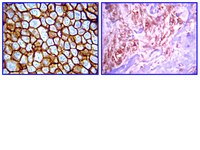05-1133 Sigma-AldrichAnti-erbB4 Antibody, clone HFR1/2G4
Detect erbB4 using this Anti-erbB4 Antibody, clone HFR1/2G4 validated for use in WB, IP, IH(P).
More>> Detect erbB4 using this Anti-erbB4 Antibody, clone HFR1/2G4 validated for use in WB, IP, IH(P). Less<<Recommended Products
Overview
| Replacement Information |
|---|
Key Specifications Table
| Species Reactivity | Key Applications | Host | Format | Antibody Type |
|---|---|---|---|---|
| H, M, R | WB, IP, IH(P) | M | Purified | Monoclonal Antibody |
| References |
|---|
| Product Information | |
|---|---|
| Format | Purified |
| Control |
|
| Presentation | Purified mouse monoclonal IgM in 0.02 M PB with 0.25 M NaCl, pH 7.6, 0.01% Sodium Azide. |
| Quality Level | MQ100 |
| Physicochemical Information |
|---|
| Dimensions |
|---|
| Materials Information |
|---|
| Toxicological Information |
|---|
| Safety Information according to GHS |
|---|
| Safety Information |
|---|
| Storage and Shipping Information | |
|---|---|
| Storage Conditions | Stable refrigerated at 2-8°C in undiluted aliquots for up to 1 year from date of receipt. |
| Packaging Information | |
|---|---|
| Material Size | 100 µg |
| Transport Information |
|---|
| Supplemental Information |
|---|
| Specifications |
|---|
| Global Trade Item Number | |
|---|---|
| Catalog Number | GTIN |
| 05-1133 | 04053252280986 |
Documentation
Anti-erbB4 Antibody, clone HFR1/2G4 SDS
| Title |
|---|
Anti-erbB4 Antibody, clone HFR1/2G4 Certificates of Analysis
| Title | Lot Number |
|---|---|
| Anti-erbB-4/HER-4, clone HFR1/2G4 - 2080297 | 2080297 |
| Anti-erbB-4/HER-4, clone HFR1/2G4 - 2197251 | 2197251 |
| Anti-erbB-4/HER-4, clone HFR1/2G4 - 3070187 | 3070187 |
| Anti-erbB-4/HER-4, clone HFR1/2G4 - 3211123 | 3211123 |
| Anti-erbB-4/HER-4, clone HFR1/2G4 - 4082279 | 4082279 |
| Anti-erbB-4/HER-4, clone HFR1/2G4 - JBC1771126 | JBC1771126 |
| Anti-erbB-4/HER-4, clone HFR1/2G4 - NG1573087 | NG1573087 |
| Anti-erbB-4/HER-4, clone HFR1/2G4 - NG1653129 | NG1653129 |
| Anti-erbB-4/HER-4, clone HFR1/2G4 - NG1815315 | NG1815315 |
| Anti-erbB-4/HER-4, clone HFR1/2G4 - NG1865041 | NG1865041 |








